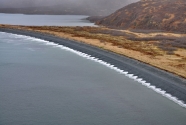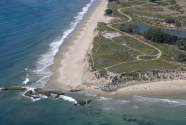
By Gary Griggs, Distinguished Professor of Earth and Planetary Sciences, Director Institute of Marine Sciences, University of California, Santa Cruz, California
There are many strikingly regular patterns in nature that have long intrigued scientists and non-scientists alike. Beach cusps are one of these. Coastal geologists and careful beach observers or frequent visitors may have noticed these evenly spaced, semicircular, scalloped-shaped patterns along the shoreline from time to time, or perhaps not at all. These very uniform patterns seem to be far more frequent on certain beaches than others, and are much more visible from an elevated vantage point, like a cliff top or in an aerial photograph, than when standing on the beach. They can form on sand or gravel beaches and can range in width or diameter from 25 to over 200 feet, but are very uniform or strikingly regular on any particular shoreline at any point in time.
The cusp spacing is shorter in gravel beaches and longer on finer-grained sandy beaches. These very symmetrical features are far easier to recognize and appreciate, however, than to figure out or understand, and we could just leave it at that and appreciate them for their symmetry. But being curious scientists, we usually look for answers to the mysteries we find in nature.
Published writing on these features goes back nearly a century to 1919 when one of the first coastal geomorphologists, Douglas Johnson, described these unique landforms.
“There are many strikingly regular patterns in nature that have long intrigued scientists and non-scientists alike. Beach cusps are one of these. ”
— Gary Griggs
Beach cusps seem to form most often when waves approach normal or at a right angle to the shoreline. The portion of the broken wave that washes up the beach face is called the swash, and the maximum difference in the run-up of the swash seems to be the dominant influence on the spacing of the cusps.
There have been two prevailing ideas on the formation of these symmetrical shoreline features, although neither is easy to explain and both probably will leave some lingering doubts in the minds of most readers. The earliest idea on the formation of cusps was that they were due to distinct properties of the waves breaking on the shoreline and were, therefore, essentially imposed on the beach by nearshore wave interactions.
In recent years, however, this theory has been essentially displaced by another idea, which involves the somewhat complicated concept known as self-organization. This principle, which has now been reproduced in models, shows that interactions between wave runup on a beach and sediment transport can combine to give rise to instability that soon produces cusps. On a flat beach, areas will develop that have slightly lower relief or elevation than adjacent areas. As waves wash up the beach, they will accelerate or speed up over these lower areas, and cause erosion. These lower areas will deepen gradually to form an embayment. On the other hand, those areas on the beach that are slightly higher will slow down the uprush of the waves, causing sediment to be deposited on top of them. These will evolve to form the horns between the embayments, and together they known as beach cusps.
Somehow, as these cusps begin to form, and they can develop quite quickly as wave conditions along the shoreline change, these features interact or communicate. As a result the patterns of erosion and deposition along the beach face (the cusps) begin to develop a very uniform size and spacing as the beach tries to rearrange itself through erosion and deposition to reduce variations along its surface.
This self-organization process, at least for now, is the favored mechanism used to explain the formation of these widespread and interesting shoreline features. They occur in both small pocket beaches but also may extend for miles down the beach, and can then disappear within a few hours as wave conditions change. Beach cusps are one of those somewhat mysterious natural phenomena that for most of us may simply be best appreciated without trying to completely understand just how they form.
























